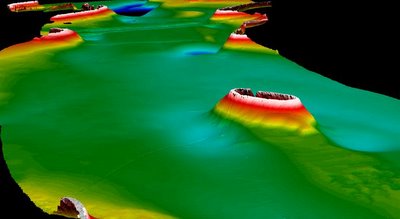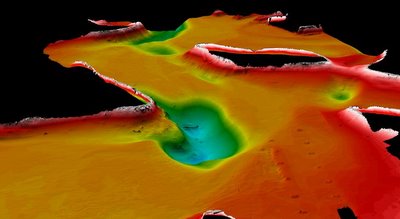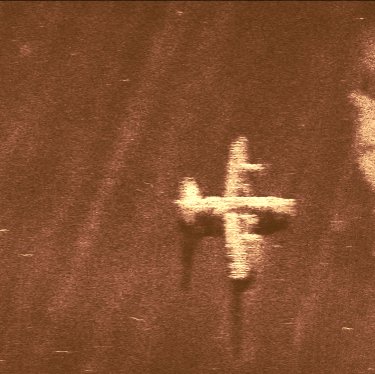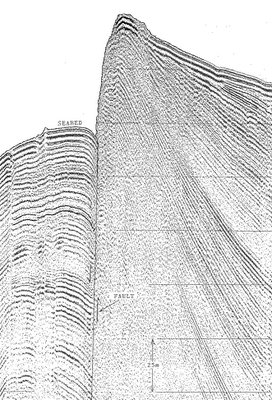


[Images: Geoacoustic topographical maps of the seafloor outside Sydney, Australia, taken by the GeoSwath].
Geoacoustics basically means using sound to map a distant landscape. This includes the seafloor: you bounce soundwaves off the bottom, and the time it takes for the echoes to come back reveals landscape depth and other topographical details – sometimes even shipwrecks and alien cities – what –
(You can read a bit more about geoacoustics through a series of PDFs at the Woods Hole Marine Seismology and Geoacoustics Group homepage).
Bats, for instance, can be said to navigate geoacoustically.
In any case, these images are geoacoustic landscape maps of the ocean floor outside Sydney, Australia –


– including an undersea plane wreck, also mapped with geoacoustics. It is unclear whether the plane is also near Sydney, however; either way, there are five or six other wreck maps to look at, and the detail is great. If you look, for instance, at the third image in this post you’ll see a shipwreck! It’s that little oblong geometric object in the bottom-center of the image – which you also see in the monochromatic version, above.
Anyway, to satisfy your inner Steve Zissou, take a look at the Woods Hole Deep Ocean Exploration Unit; and check out these films of echo-scattering on submerged topography. (For another cool film – a simulation of last year’s Asian tsunami – see BLDGBLOG’s earth.mov).
Finally, two more geoacoustic maps:

[Image: A geoacoustic map of the bottom of Lake Vattern, Sweden].

[Image: Geoacoustic map of a faultine off Indonesia].
Perhaps in a few hundred years we’ll be producing geoacoustic maps of a submerged New Orleans, or a London done under by tides and estuarial flooding. The undersea canyons of New York, former archipelago.
It’d be interesting, meanwhile, if you could take geoacoustic data and release it as an MP3: you could then listen to the suboceanic landscape’s raw sonic topography, compressed aquatic echoes, complete with deepsea ridges and audio-thermal vents. Non-visual mapping of unreachable landscapes. An MP3 of the surface of Mars. The rings of Saturn.
lovely post, Geoff
“..if you could take raw geoacoustic data and release it as an MP3: you could then listen to the suboceanic landscape’s..”
Not exactly the same but.. check John Duncan’s work with seismic & tidal datas
INFRASOUND-TIDAL
ingeos – or Cédric? – check out the singing icebergs, too, and also Sound dunes and even Podcasting the sun. Then there’s this post on sound mirrors. Landscape acoustics are my secret favorite subject. Also, do you know the site ShortWaveMusic? Check it out! Some amazing MP3s up there.
And thank you, Senor Larsen. Perhaps all these acoustic landscapes could form an installment of Par Avion someday…
(Yes here’s Cédric) – thanks for all these links.
Speaking of “…raw geoacoustic data and release it as an MP3…” there is also an interesting track by ‘bob l. sturm’ based on the coastal data information program, on the lowercase compilation CD on bremsstrahlung-recordings.
Well, there is that then. However, it’s Avian like the bird (not Avion like the mail… common mistake). And that ball is, as they say, in your court.
pip pip.
Once I get my contact mics installed beneath London, and I’ve echo-scattered the Pacific seafloor a few times… I’ll be in touch. If I can’t give you the recordings in person, of course, I’ll send them par avian…
And, Cédric, I may even post about Francisco Lopez soon – or at least quote him. Noticed him on that website you link to. I’ll post that in January, maybe…? Also, check out this older post: it’s the silophone.